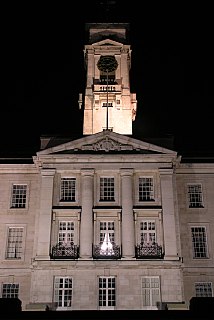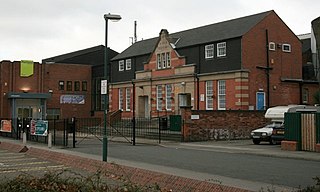


Bromley and Watkins was an architectural practice based in Nottingham from 1912 to 1928.



Bromley and Watkins was an architectural practice based in Nottingham from 1912 to 1928.
Albert Nelson Bromley and Harry Garnham Watkins established the practice in Nottingham in 1912. [1] Harry Garnham Watkins was the son of William Watkins, an architect from Lincoln. The partnership was dissolved in 1928 [2] when Harry Garnham Watkins retired.

Earle Foxe was an American actor.

Watson Fothergill was a British architect who designed over 100 unique buildings in Nottingham in the East Midlands of England, his influences were mainly from the Gothic Revival and Old English vernacular architecture styles.
Thomas Cecil Howitt, OBE was a British provincial architect of the 20th Century. Howitt is chiefly remembered for designing prominent public buildings, such as the Council House and Processional Way in Nottingham, Baskerville House in Birmingham, Newport Civic Centre, and several Odeon cinemas. Howitt's chief architectural legacies are in his home city of Nottingham. He was Housing Architect for the City Council, designing municipal housing estates which are often considered to be among the finest in terms of planning in the country.

Bromley House Library is a subscription library in Nottingham.
Captain Basil Edgar Baily FRIBA was an architect based in Nottingham. Much of his earlier work had to do with nearby churches.

William Watkins (1834–1926) was an architect who worked in Lincoln, England, and is particularly noted for his Terracotta Revival Architecture.

Percy Richard Morley Horder was an English architect who early in his career worked from offices in Stroud and later in London. His early work included public houses for the Godsell Brewery work included the designing of new country houses or partially rebuilding existing houses. He also designed country house gardens and is noted for laying out Highfields Park, Nottingham together with the adjacent Nottingham University Campus. His early work was in the Arts and Crafts style, but after the First World War his buildings were increasingly in the Neo-Georgian fashion. He undertook architectural work in many parts of the British Isles including Ireland and at Thurso in Caithness. He is probably best remembered for the Trent Building in the University of Nottingham. and for design of the London School of Hygiene and Tropical Medicine. His work at Upton House, Warwickshire for Viscount Bearsted is notable, but it is his work for Jesse Boot, both the Boot's the Chemists stores, but most importantly the Trent Building and the laying out of the Nottingham University Campus, which influenced design at other English universities, for which he must take the greatest credit.

Naylor and Sale was an architectural practice based in Derby between 1887 and 1923.

Samuel Dutton Walker F.S.A. was an architect based in Nottingham.

William Arthur Heazell FRIBA was an architect based in Nottingham.

Long Row is a row of retail buildings in Nottingham City Centre forming the north side of Old Market Square, Nottingham.

Albert Nelson Bromley was an English architect based in Nottingham.

William Beedham Starr JP was an architect based in Nottingham.

Alfred John Thraves FRIBA was an architect based in Nottingham who specialised in cinema design.

Evans, Clark and Wollatt was an architectural practice based in Nottingham from the early 1920s to 1948.
Bromley, Cartwright and Waumsley was an architectural practice based in Nottingham from 1928 to 1948.

Ernest Richard Eckett Sutton FRIBA was an English architect based in Nottingham.

Arthur Dale LRIBA (1859-1931) was an English architect based in Nottingham.

Captain Albert Edgar Eberlin FRIBA MC was an architect based in Nottingham.

Harry Beswick FRIBA was County Architect for Chester from 1895 until 1926.